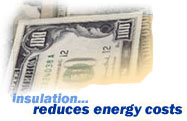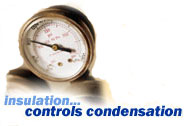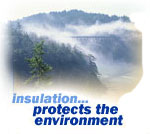Do you know all of insulation’s benefits?
A properly designed and installed insulation system offers immediate and long-term benefits. Insulation protects your personnel, your equipment, your system, and your budget. Click here to learn more about the Power of Insulation.
- Reduces energy costs
- Prevents moisture condensation
- Reduces capacity and size of new mechanical equipment
- Enhances process performance
- Reduces emissions of pollutants
- Safety and protection of personnel
- Acoustical performance: reduces noise levels
- Maximizes return on investment (ROI)
- Improves Appearance
- Fire Protection

Energy Savings: Insulation Reduces Energy Costs
A properly designed and installed insulation system immediately reduces the need for energy and results in significant savings.
On hot pipes and surfaces, heat loss can be reduced by about 20 times. With delivered natural gas and fuel oil costs at $7 to $10 per million Btus, that adds up!
A properly designed, insulated, and maintained system significantly reduces energy costs, which saves money and protects the environment. An unbelievable amount of energy is lost through uninsulated valves, bare pipes, or defective insulation. It seems to be one of those maintenance things that never gets done—until somebody can demonstrate what it's costing to ignore the uninsulated system.
Energy Savings Appraisal
A properly designed and installed insulation system immediately reduces the need for energy and results in significant savings. A Certified Insulation Energy Appraiser can document the actual Btu/dollars savings and calculate potential savings with an insulation upgrade. Click here for more information about becoming a Certified Insulation Energy Appraiser.

Impressive Return on Investment: Insulation Is a Quick Payback
- Reduced energy cost means improved ROI.
- Addition of insulation can be the most cost-effective means of reducing O&M costs for an industrial facility or a commercial building.
A properly designed and installed insulation system provides an excellent return on investment and quick payback through cost savings. Insulation is a low-risk investment because the savings and the payback can be forecasted with a high degree of accuracy. To calculate your specific payback, download a free computer program (called 3E Plus®) at www.pipeinsulation.org or use the fast, simple insulation calculators created by NIA and available at www.insulation.org/training-tools/designguide/simple-calculators.
Insulation is one of the few technologies where the payback for the investment is considered more than acceptable when compared to many other equipment or maintenance purchases. If the insulated system is maintained, the savings from the investment continue for the life of the facility. In fact, it costs more to not insulate properly. Often insulation is paid for by the maintenance budget and then it reduces the operations budget for the life of the system.
The return on investment or payback for an investment in insulation is quick, often from 6 months to 2 years.

Control Condensation with Insulation
Insulation with a good vapor retarder controls condensation and limits corrosion on cold piping, ducts, chillers, and roof drains. Sufficient thickness is needed to keep the surface temperature above the dew point temperature of the ambient air.
- Keep surface temperatures above dew point.
- Prevent costly moisture damage to building materials.
- Prevent mold and mildew growth.
- Reduce energy costs for operating chillers and refrigeration equipment.
FAQ: How Does Insulation Help Control Condensation?
When piping and equipment operate at temperatures lower than the ambient air, moisture in the air will condense, or freeze, on or within the insulation surface, or on the cold pipe surface. Unless the system is protected by sufficient thickness and by adequate vapor retarders, the insulation can become wet, causing corrosion, and causing the insulation to become ineffective. Specifying sufficient insulation thickness with an effective vapor retarder system is the most effective means of providing a system for controlling condensation on the membrane surface and within the insulation system on cold piping, ducts, chillers, and roof drains. Sufficient insulation thickness is needed to keep the surface temperature of the membrane above the highest possible design dew point temperature of the ambient air so condensation does not form on the surface. The effective vapor retarder system is needed to restrict moisture migration into the system through the facing, joints, seams, penetrations, hangers, and supports. By controlling condensation, the system designer may control the potential for:
- Degrading system service life and performance;
- Mold growth and the potential for health problems resulting from water condensate; and
- Corrosion of pipes, valves, and fittings caused by water collected and contained within insulation system.

Process Control with Insulation
A properly specified and installed insulation system on bare process lines and equipment can increase the efficiency of a process system by as much as 95% or more.
Use insulation to:
- Maintain process temperatures;
- Improve product QC; and
- Improve operating safety.

Protect the Environment by Reducing Pollutant Emissions with Insulation
Use a well-designed and insulated system for greenhouse gas reduction.
- Lower energy use means less pollution (particulate, VOCs, CEs, NOX, SOX, carbon monoxide, mercury, etc.).
- Improved performance of pollution control equipment.
Insulation reduces energy consumption, which means that less fossil fuel is burned to produce that energy. This, in turn, decreases the amount of polluting gases such as carbon dioxide and sulfur dioxide emitted into the atmosphere. Because carbon dioxide is one of the principal greenhouse gases contributing to global warming, and sulfur dioxide is the major component of acid rain, insulation plays a significant role in protecting the environment.
Insulation is not generally associated with pollution control. If energy is saved, then all of the pollution associated with the generation of that energy is also saved. And, given the amount of energy reduced by the use of insulation—and the fact that we now have tools to calculate the emission reduction numbers with the use of insulation—emission reduction is a significant benefit of insulating in today's green environment.

Personnel Protection
A well-designed and insulated system will protect personnel by:
- Lowering hot surface temperatures; and
- Preventing accidental burns.
Thermal insulation is one of the most effective means of protecting workers from burns resulting from contact with hot or extremely cold piping and equipment. For hot surfaces especially, insulation reduces the surface temperature of piping or equipment to a safer level, resulting in increased worker safety and the avoidance of worker downtime due to injury. With today's specification tools, it's very easy to calculate the insulation thickness needed to bring the surface temperature of your piping and equipment to safe levels.
In addition to the safety benefits of insulation, NIA member companies take job site safety very seriously and strive to meet the highest standards to protect their own personnel.

Fire Protection
Used in combination with other materials, insulation helps provide fire protection in firestop systems, grease and air ducts, and in electrical and communications conduits and cables.

Improved Appearance
Insulation covering exposed air conditioning and plumbing lines gives a finished appearance to a building.

Noise Control with Insulation
A well-insulated system helps reduce noise levels by:
- Absorbing emitted sound;
- Meeting OSHA requirements by eliminating sound at the source; and
- Improving the work environment by improving worker morale and communication.
This is one benefit that's tough to put a price on, but we all know it happens. Noise can seriously impact a worker's health and productivity—so much so that OSHA does in fact have noise standards in place. Manufacturing environments can be extremely noisy and cause major health problems if noise abatement and protection are not dealt with. In addition, noise produced by appliances, piping, heating and air conditioning systems, phones, radios, and even by talking are major reasons people are dissatisfied with their work place.
Insulation materials are used to encase or enclose noise generating sources and reduce noise to acceptable levels so that stress, lost time, and dissatisfaction do not impact the employee and/or the product you are trying to get out the door.
Insulation reduces the level of both exterior and interior noise by preventing transmission of exterior sounds to the interior of the building, and absorbing reverberating sounds within the building.
FAQ: How and Why Is Insulation Used to Control Sound?
Sound attenuation, or the limiting of sound propagation from one area to another, requires the application of special and standard insulation materials to encase or enclose the noise-generating source, forming a sound barrier between the source and the surrounding area.
The purposes of applying sound-attenuation materials are to:
- Reduce obnoxious noise levels emitting from machines, equipment, pipe lines, or enclosures;
- Reduce general noise level in plant areas;
- Provide for better work conditions; and
- Comply with noise level standards of OSHA and EPA.

Increase Space Efficiency with Insulation
A well-insulated system will:
- Reduce capacity and size of new mechanical equipment;
- Reduce capital cost of equipment;
- Reduce space required for equipment; and
- Reduce maximum electrical loads, meaning reduced electrical rates for industrial and commercial users.
